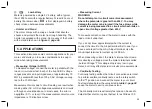
29
⑫
Low battery
Meter is powered by a single 9 V battery, with a typical
life of 200 hours with a regular battery. At least 8 hours of
battery Iife remain when
is first displayed. A battery
check is taken between measurements.
– Holster and stand
The meter comes with a snap-on holster that absorbs
shocks and protects the meter from rough handling. The
holster is equipped with a stand. Some uses of the holster
with a stand are shown in
figure 3, page 46.
5. APPLICATIONs
This section discusses some common applications for your
meter, and alerts you to some considerations to keep in
mind when taking measurements.
– Measuring Voltage (AC/DC)
To measure voltage, connect the meter in parallel with the
load or circuit under test. Each of the five AC/DC voltage
ranges presents an input impedance of approximately 10
MΩ in parallel with less than 100 pF. AC Voltage is acoup-
led to the 10 MΩ input.
Measurement errors due to circuit loading can result when
making either AC or DC voltage measurements on circuits
with high source impedance. In most cases, the error is
negligible (0.1 % or less) if the measurement circuit source
impedance is 10 kiloohms or less.
– Measuring Current
WARNING
Do not attempt an in-circuit current measurement
where the potenials is greater than 600 V. You may
damage the meter or be injured if the fuse blows while
current is being measured in a circuit which exhibits an
open circuit voltage greater than 600 V.
To measure current, connect the meter in series with the
load or circuit under test.
If you do not know approximately what the current is,
connect the circuit to the A input terminal first to see if you
have a safe level for the mA
μ
A input terminal. Use the
mA
μ
A input terminal for current up to 200 mA.
When measuring current, the meter‘s internal shunt resis-
tors develop a voltage across the meter‘s terminals called
„burden Voltage.“ This voltage drop is very low in your
meter, but it may affect precision circuits or measurements.
– Continuity Testing
Continuity testing verifies that circuit connections are intact.
To perform audible continuity tests, see the rotary switch
to the position, and connect the meter to your circuit.
Test resistance below the value Iisted in
table 2, page 28
cause the meter to emit a continuous tone.
The continuity mode is extremely fast and can be used to
detect either shorts or opens that last for as Iittle as 100
















































